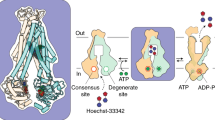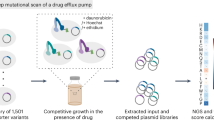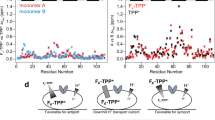Abstract
Multidrug resistance is a serious threat to public health. Proton motive force-driven antiporters from the major facilitator superfamily (MFS) constitute a major group of multidrug-resistance transporters. Currently, no reports on crystal structures of MFS antiporters in complex with their substrates exist. The E. coli MdfA transporter is a well-studied model system for biochemical analyses of multidrug-resistance MFS antiporters. Here, we report three crystal structures of MdfA-ligand complexes at resolutions up to 2.0 Å, all in the inward-facing conformation. The substrate-binding site sits proximal to the conserved acidic residue, D34. Our mutagenesis studies support the structural observations of the substrate-binding mode and the notion that D34 responds to substrate binding by adjusting its protonation status. Taken together, our data unveil the substrate-binding mode of MFS antiporters and suggest a mechanism of transport via this group of transporters.
Similar content being viewed by others
Log in or create a free account to read this content
Gain free access to this article, as well as selected content from this journal and more on nature.com
or
References
McKenna M . Antibiotic resistance: the last resort. Nature 2013; 499:394–396.
Zhang Q, Lambert G, Liao D, et al. Acceleration of emergence of bacterial antibiotic resistance in connected microenvironments. Science 2011; 333:1764–1767.
Higgins CF . Multiple molecular mechanisms for multidrug resistance transporters. Nature 2007; 446:749–757.
Putman M, van Veen HW, Konings WN . Molecular properties of bacterial multidrug transporters. Microbiol Mol Biol Rev 2000; 64:672–693.
Fluman N, Bibi E . Bacterial multidrug transport through the lens of the major facilitator superfamily. Biochim Biophys Acta 2009; 1794:738–747.
Pao SS, Paulsen IT, Saier MH Jr. Major facilitator superfamily. Microbiol Mol Biol Rev 1998; 62:1–34.
Paulsen IT, Brown MH, Skurray RA . Proton-dependent multidrug efflux systems. Microbiol Rev 1996; 60:575–608.
Huang Y, Lemieux MJ, Song J, Auer M, Wang DN . Structure and mechanism of the glycerol-3-phosphate transporter from Escherichia coli. Science 2003; 301:616–620.
Abramson J, Smirnova I, Kasho V, Verner G, Kaback HR, Iwata S . Structure and mechanism of the lactose permease of Escherichia coli. Science 2003; 301:610–615.
Dang S, Sun L, Huang Y, et al. Structure of a fucose transporter in an outward-open conformation. Nature 2010; 467:734–738.
Edgar R, Bibi E . MdfA, an Escherichia coli multidrug resistance protein with an extraordinarily broad spectrum of drug recognition. J Bacteriol 1997; 179:2274–2280.
Wang D, Hu E, Chen J, Tao X, Gutierrez K, Qi Y . Characterization of novel ybjG and dacC variants in Escherichia coli. J Med Microbiol 2013; 62:1728–1734.
Fluman N, Ryan CM, Whitelegge JP, Bibi E . Dissection of mechanistic principles of a secondary multidrug efflux protein. Mol Cell 2012; 47:777–787.
Smirnova IN, Kasho V, Kaback HR . Protonation and sugar binding to LacY. Proc Natl Acad Sci USA 2008; 105:8896–8901.
Zhao Y, Mao G, Liu M, Zhang L, Wang X, Zhang XC . Crystal structure of the E. coli peptide transporter YbgH. Structure 2014; 22:1–9.
Varela MF, Sansom CE, Griffith JK . Mutational analysis and molecular modelling of an amino acid sequence motif conserved in antiporters but not symporters in a transporter superfamily. Mol Membr Biol 1995; 12:313–319.
Jiang D, Zhao Y, Wang X, et al. Structure of the YajR transporter suggests a transport mechanism based on the conserved motif A. Proc Natl Acad Sci USA 2013; 110:14664–14669.
Paulsen IT, Skurray RA . Topology, structure and evolution of two families of proteins involved in antibiotic and antiseptic resistance in eukaryotes and prokaryotes — an analysis. Gene 1993; 124:1–11.
Kimura T, Nakatani M, Kawabe T, Yamaguchi A . Roles of conserved arginine residues in the metal-tetracycline/H+ antiporter of Escherichia coli. Biochemistry 1998; 37:5475–5480.
Edgar R, Bibi E . A single membrane-embedded negative charge is critical for recognizing positively charged drugs by the Escherichia coli multidrug resistance protein MdfA. EMBO J 1999; 18:822–832.
Yin Y, He X, Szewczyk P, Nguyen T, Chang G . Structure of the multidrug transporter EmrD from Escherichia coli. Science 2006; 312:741–744.
Steed PR, Zou P, Trone KE, McHaourab HS . Structure and pH-Induced structural rearrangements of the putative multidrug efflux pump EmrD in liposomes probed by site-directed spin labeling. Biochemistry 2013; 52:7964–7974.
Dunkle JA, Xiong L, Mankin AS, Cate JH . Structures of the Escherichia coli ribosome with antibiotics bound near the peptidyl transferase center explain spectra of drug action. Proc Natl Acad Sci USA 2010; 107:17152–17157.
Ethayathulla AS, Yousef MS, Amin A, Leblanc G, Kaback HR, Guan L . Structure-based mechanism for Na(+)/melibiose symport by MelB. Nat Commun 2014; 5:3009.
Sigal N, Fluman N, Siemion S, Bibi E . The secondary multidrug/proton antiporter MdfA tolerates displacements of an essential negatively charged side chain. J Biol Chem 2009; 284:6966–6971.
Lewinson O, Padan E, Bibi E . Alkalitolerance: a biological function for a multidrug transporter in pH homeostasis. Proc Natl Acad Sci USA 2004; 101:14073–14078.
Pasrija R, Banerjee D, Prasad R . Structure and function analysis of CaMdr1p, a major facilitator superfamily antifungal efflux transporter protein of Candida albicans: identification of amino acid residues critical for drug/H+ transport. Eukaryotic Cell 2007; 6:443–453.
Zhao Y, Terry D, Shi L, Weinstein H, Blanchard SC, Javitch JA . Single-molecule dynamics of gating in a neurotransmitter transporter homologue. Nature 2010; 465:188–193.
Adler J, Bibi E . Determinants of substrate recognition by the Escherichia coli multidrug transporter MdfA identified on both sides of the membrane. J Biol Chem 2004; 279:8957–8965.
Paul S, Alegre KO, Holdsworth SR, et al. A single-component multidrug transporter of the major facilitator superfamily is part of a network that protects Escherichia coli from bile salt stress. Mol Microbiol 2014; 92:872–884.
Alguel Y, Meng C, Teran W, et al. Crystal structures of multidrug binding protein TtgR in complex with antibiotics and plant antimicrobials. J Mol Biol 2007; 369:829–840.
Lu M, Radchenko M, Symersky J, Nie R, Guo Y . Structural insights into H+ coupled multidrug extrusion by a MATE transporter. Nat Struct Mol Biol 2013; 20:1310–1317.
Seeger MA, Schiefner A, Eicher T, Verrey F, Diederichs K, Pos KM . Structural asymmetry of AcrB trimer suggests a peristaltic pump mechanism. Science 2006; 313:1295–1298.
Sigal N, Molshanski-Mor S, Bibi E . No single irreplaceable acidic residues in the Escherichia coli secondary multidrug transporter MdfA. J Bacteriol 2006; 188:5635–5639.
Adler J, Bibi E . Promiscuity in the geometry of electrostatic interactions between the Escherichia coli multidrug resistance transporter MdfA and cationic substrates. J Biol Chem 2005; 280:2721–2729.
Tirosh O, Sigal N, Gelman A, et al. Manipulating the drug/proton antiport stoichiometry of the secondary multidrug transporter MdfA. Proc Natl Acad Sci USA 2012; 109:12473–12478.
Lewinson O, Adler J, Poelarends GJ, Mazurkiewicz P, Driessen AJ, Bibi E . The Escherichia coli multidrug transporter MdfA catalyzes both electrogenic and electroneutral transport reactions. Proc Natl Acad Sci USA 2003; 100:1667–1672.
Schuster-Bockler B, Schultz J, Rahmann S . HMM Logos for visualization of protein families. BMC Bioinformatics 2004; 5:7.
Sigal N, Vardy E, Molshanski-Mor S, et al. 3D model of the Escherichia coli multidrug transporter MdfA reveals an essential membrane-embedded positive charge. Biochemistry 2005; 44:14870–14880.
De Jesus M, Jin J, Guffanti AA, Krulwich TA . Importance of the GP dipeptide of the antiporter motif and other membrane-embedded proline and glycine residues in tetracycline efflux protein Tet(L). Biochemistry 2005; 44:12896–12904.
Fan J, Heng J, Dai S, et al. An efficient strategy for high throughput screening of recombinant integral membrane protein expression and stability. Protein Expr Purif 2011; 78:6–13.
Otwinowski Z, Minor W . Processing of X-ray diffraction data collected in oscillation mode. Macromol Crystallogr Pt A 1997; 276:307–326.
Pape T, Schneider TR . HKL2MAP: a graphical user interface for macromolecular phasing with SHELX programs. J Appl Crystallogr 2004; 37:843–844.
Emsley P, Cowtan K . Coot: model-building tools for molecular graphics. Acta Crystallogr D Biol Crystallogr 2004; 60:2126–2132.
Davis IW, Murray LW, Richardson JS, Richardson DC . MOLPROBITY: structure validation and all-atom contact analysis for nucleic acids and their complexes. Nucleic Acids Res 2004; 32:W615–W619.
Miroux B, Walker JE . Over-production of proteins in Escherichia coli: mutant hosts that allow synthesis of some membrane proteins and globular proteins at high levels. J Mol Biol 1996; 260:289–298.
Acknowledgements
We thank the staff of the Protein Research Core Facility at the Institute of Biophysics, Chinese Academy of Sciences (CAS) for their excellent technical support. We are grateful to staff members of SSRF (China), SPring-8 (Japan) and KEK Photon Factory (Japan) synchrotron facilities for their assistance in crystal screening and data collection. We also thank Dr Zhenfeng Liu for the help with data collection, and Dr Juelich T for linguistic assistance during the preparation of this manuscript. This work was supported by the National Basic Research Program of China (973 Program; 2011CB910301 and 2014CB910104 to XCZ, and 2014CB910400 to YFZ), the Chinese Academy of Sciences (XDB08020301 to XCZ) and the National Natural Science Foundation of China (31470745 to XCZ, and 31200560 to XW).
Author information
Authors and Affiliations
Corresponding authors
Additional information
( Supplementary information is linked to the online version of the paper on the Cell Research website.)
Supplementary information
Supplementary information, Figure S1
Analysis of amino acid sequences of MdfA (PDF 746 kb)
Supplementary information, Figure S2
The WebLogo representation of MFS transporters. (PDF 107 kb)
Supplementary information, Figure S3
Structural comparison between MdfA and YajR. (PDF 185 kb)
Supplementary information, Figure S4
Substrate binding in MdfA (PDF 119 kb)
Supplementary information, Figure S5
Actual ligands in our crystal structures in comparison to related known substrates. (PDF 40 kb)
Supplementary information, Figure S6
Binding of deoxycholate with MdfA (PDF 59 kb)
Supplementary information, Figure S7
Chloramphenicol-resistance assay. (PDF 183 kb)
Supplementary information, Figure S8
Stereo view of distribution of residues discussed in the main text. (PDF 62 kb)
Supplementary information, Table S1
Statistics of diffraction data and structure refinement (PDF 81 kb)
Supplementary information, Table S2
Formation of ligand binding sites. (PDF 39 kb)
Supplementary information, Table S3
Bulk dye anisotropy measurements. (PDF 71 kb)
Supplementary information, Data S1
Supplementary methods (PDF 96 kb)
Supplementary information, Data S2
Additional results and discussion (PDF 73 kb)
Rights and permissions
About this article
Cite this article
Heng, J., Zhao, Y., Liu, M. et al. Substrate-bound structure of the E. coli multidrug resistance transporter MdfA. Cell Res 25, 1060–1073 (2015). https://doi.org/10.1038/cr.2015.94
Received:
Revised:
Accepted:
Published:
Issue date:
DOI: https://doi.org/10.1038/cr.2015.94
Keywords
This article is cited by
-
Transport and inhibition mechanisms of human VMAT2
Nature (2024)
-
Deep mutational scan of a drug efflux pump reveals its structure–function landscape
Nature Chemical Biology (2023)
-
Structural basis for inhibition of the drug efflux pump NorA from Staphylococcus aureus
Nature Chemical Biology (2022)
-
Protein over-expression in Escherichia coli triggers adaptation analogous to antimicrobial resistance
Microbial Cell Factories (2021)
-
An embedded lipid in the multidrug transporter LmrP suggests a mechanism for polyspecificity
Nature Structural & Molecular Biology (2020)



